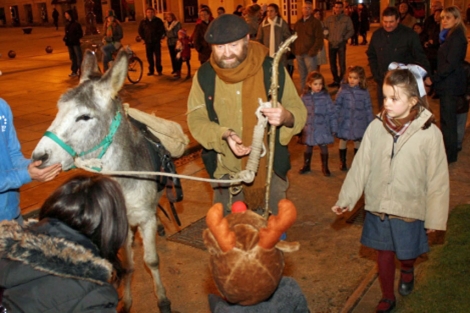Santa Claus and the Three Wise Men have earned their well-deserved reputation, but they are not Spain's only protagonists during Christmas. Although less known, there are other very peculiar characters who always visit us around these times. From the Olentzero to the Caga Tió, the one who doesn't bring gifts still brings peace and love, something less materialistic but equally important. Discover more about these interesting Christmas characters, maybe one of them will visit your home in the coming weeks....
Basque Country: Olentzero
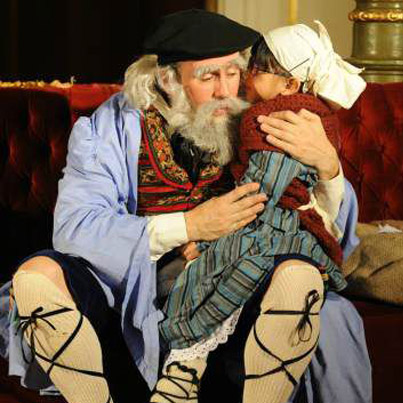 Olentzero is a coal miner who brings presents on Christmas Eve to those living in the Basque Country and Navarre. Towns, cities, and neighborhoods normally have a procession the day before Christmas with a doll that represents him. Although the origin of this tradition is unknown, some sources indicate that it comes from the winter solstices, when the doll would be set on fire to symbolize the burning of the old to make way for the new; a renewal for the following year. The tradition of fire still continues today but in the modern version the character is someone who comes down from the mountains to announce the birth of Jesus.
Olentzero is a coal miner who brings presents on Christmas Eve to those living in the Basque Country and Navarre. Towns, cities, and neighborhoods normally have a procession the day before Christmas with a doll that represents him. Although the origin of this tradition is unknown, some sources indicate that it comes from the winter solstices, when the doll would be set on fire to symbolize the burning of the old to make way for the new; a renewal for the following year. The tradition of fire still continues today but in the modern version the character is someone who comes down from the mountains to announce the birth of Jesus.
Asturias: Guirria and Anguleru
.jpg) This is said to be one of the oldest traditions of the municipality of Ponga. Every New Year's Eve, the boys ride out on horseback accompanied by this half man-half demon character and they roam the streets looking for single women. The character kisses these women as it throws ashes at the boys. But it's not only the Guirria who steals kisses. Single people over 15 years old, both men and women, are paired up by pulling names from jars and they promise to have dinner together one night. Another tradition that still remains today despite the passage of time occurs on the last night of the year and that is when the Guirria and his court go door to door asking for a Christmas bonus. Asturias also has another character who is called l'Anguleru. This character comes from the Sargasso Sea and, like Santa Claus, arrives on Christmas Eve bearing gifts for the little ones.
This is said to be one of the oldest traditions of the municipality of Ponga. Every New Year's Eve, the boys ride out on horseback accompanied by this half man-half demon character and they roam the streets looking for single women. The character kisses these women as it throws ashes at the boys. But it's not only the Guirria who steals kisses. Single people over 15 years old, both men and women, are paired up by pulling names from jars and they promise to have dinner together one night. Another tradition that still remains today despite the passage of time occurs on the last night of the year and that is when the Guirria and his court go door to door asking for a Christmas bonus. Asturias also has another character who is called l'Anguleru. This character comes from the Sargasso Sea and, like Santa Claus, arrives on Christmas Eve bearing gifts for the little ones.
Catalonia: Caga Tió and Caganer
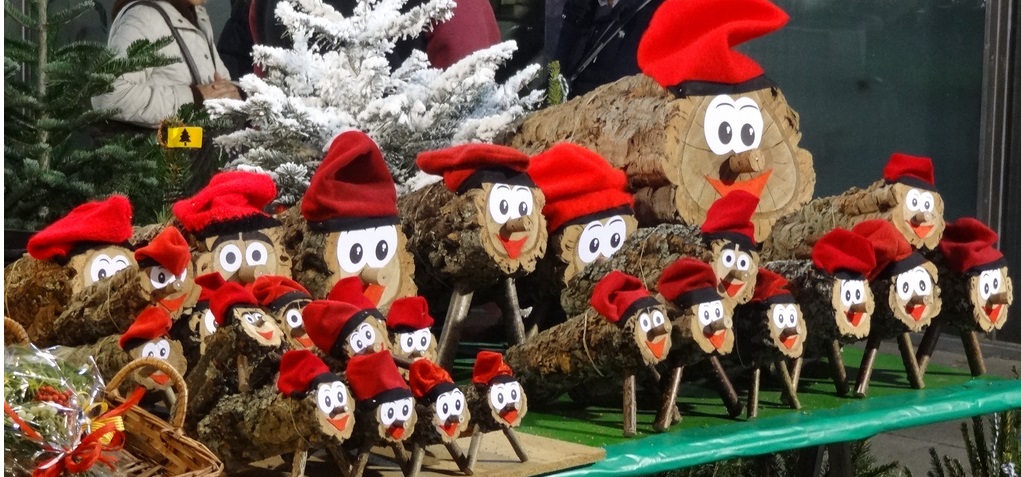
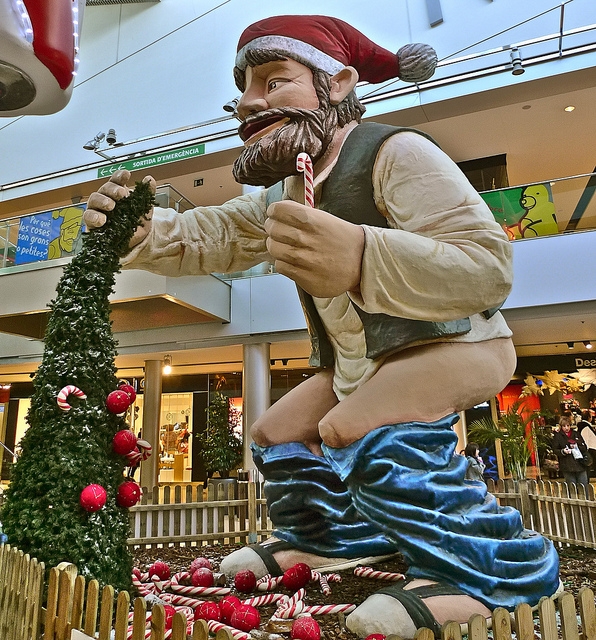 Although it may be a bit difficult for the rest of us to understand, in Catalonia children not only receive a visit from Santa Claus and the Three Kings, but also that from a log. It is not just any log, in fact, it is magical and it's called the Caga Tió. It arrives at homes on December 8th and stays until Christmas. During this time, it is always covered by a blanket and is fed daily with food scraps, fruit, and bread. On Christmas Eve, the children sing a traditional song while they hit the Caga Tió with a stick. As a result, this curious character "poops" gifts. The origin of the tradition is said to have come from the logs burned in the earthen fires at home since they provided everything the home needed: heat, light, and even a place to cook. Although the gifts were initially little things like sweets or candies, today the Caga Tió gives all kinds of presents.
Although it may be a bit difficult for the rest of us to understand, in Catalonia children not only receive a visit from Santa Claus and the Three Kings, but also that from a log. It is not just any log, in fact, it is magical and it's called the Caga Tió. It arrives at homes on December 8th and stays until Christmas. During this time, it is always covered by a blanket and is fed daily with food scraps, fruit, and bread. On Christmas Eve, the children sing a traditional song while they hit the Caga Tió with a stick. As a result, this curious character "poops" gifts. The origin of the tradition is said to have come from the logs burned in the earthen fires at home since they provided everything the home needed: heat, light, and even a place to cook. Although the gifts were initially little things like sweets or candies, today the Caga Tió gives all kinds of presents.
This character, however, is not the only one with a scatological nature in the Catalan Christmas. Every year the famous Caganer, the figurine of a young herder defecating, appears in the nativity scene. In recent years caganers have been characterized as some of the year's most famous people. This is a tradition that now appears in nativity scenes throughout Spain.
Galicia: O Apalpador
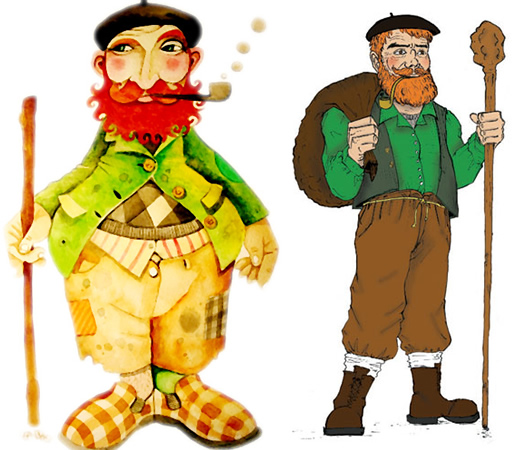 Galicia also has a curious character whose presence during the holidays has recently reappeared although its origin is very old. It is Apalpador, a first cousin of Olentzero, who has the strange habit of coming down from the mountains to pat children's bellies and see if they have eaten well during the year. The figure of this coal miner with a big belly and a red beard lives in the Galician mountains near the regions of O Cebreiro, Os Ancares, and O Courel. He comes down from here on Christmas Night and New Year's Eve. Originally, it was said that he visited homes on these special days to see if children were being well fed and if not, he would leave some chestnuts for them to eat (now he usually brings an extra present too). We can find a very similar character in Ecija, Seville. We are talking about Tientapanzas, the character who visits children at night to see if they have eaten well and then informs the Three Wise Men whether or not they deserve gifts. This tradition resumed in 2004 and since then even a parade through the village streets is held to greet him.
Galicia also has a curious character whose presence during the holidays has recently reappeared although its origin is very old. It is Apalpador, a first cousin of Olentzero, who has the strange habit of coming down from the mountains to pat children's bellies and see if they have eaten well during the year. The figure of this coal miner with a big belly and a red beard lives in the Galician mountains near the regions of O Cebreiro, Os Ancares, and O Courel. He comes down from here on Christmas Night and New Year's Eve. Originally, it was said that he visited homes on these special days to see if children were being well fed and if not, he would leave some chestnuts for them to eat (now he usually brings an extra present too). We can find a very similar character in Ecija, Seville. We are talking about Tientapanzas, the character who visits children at night to see if they have eaten well and then informs the Three Wise Men whether or not they deserve gifts. This tradition resumed in 2004 and since then even a parade through the village streets is held to greet him.
